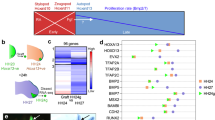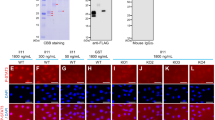Abstract
THE first inductive interaction in amphibian development is mesoderm induction, when a signal from the vegetal hemisphere of the blastula induces mesoderm from overlying equatorial cells1,2. Recently, several 'mesoderm-inducing factors' (MIFs) have been discovered. These cause isolated Xenopus animal caps to form mesodermal cell types such as muscle, instead of their normal fate of epidermis. The MIFs fall into two classes. One comprises members of the fibroblast growth factor (FGF) family3–5, and the other members of the transforming growth factor type β (TGF-β) family6–7. Of the latter group, the most potent is XTC-MIF, a protein produced by Xenopus XTC cells8–10. Here we show that XTC-MIF is the homologue of mammalian activin A. Activins modulate the release of follicle-stimulating hormone from cultured anterior pituitary cells11,12 and cause the differentiation of two erythroleukaemia cell lines13,14. Our results indicate that these molecules may also act in early development during formation of the mesoderm.
This is a preview of subscription content, access via your institution
Access options
Subscribe to this journal
Receive 51 print issues and online access
$199.00 per year
only $3.90 per issue
Buy this article
- Purchase on Springer Link
- Instant access to full article PDF
Prices may be subject to local taxes which are calculated during checkout
Similar content being viewed by others
References
Smith, J. C. Development 105, 665–677 (1989).
Dawid, I. B., Sargent, T. D. & Rosa, F. Curr. Topics dev. Biol. (in the press).
Slack, J. M. W., Darlington, B. G., Heath, J. K. & Godsave, S. F. Nature 326, 197–200 (1987).
Kimelman, D. & Kirschner, M. Cell 51, 869–877 (1987).
Paterno, G. D., Gillespie, L. L., Dixon, M. S., Slack, J. M. W. & Heath, J. K. Development 106, 79–83 (1989).
Rosa, F. et al. Science 239, 783–785 (1988).
Weeks, D. L. & Melton, D. A. Cell 51, 861–867 (1987).
Smith, J. C. Development 99, 3–14 (1987).
Smith, J. C., Yaqoob, M. & Symes, K. Development 103, 591–600 (1988).
Green, J. B. A., Howes, G., Symes, K., Cooke, J. & Smith, J. C. Development 108, 173–183 (1990).
Vale, W. et al. Nature 321, 776–779 (1986).
Ling, N. et al. Nature 321, 779–782 (1986).
Eto, Y. et al. Biochem. biophys. Res. Commun. 142, 1095–1103 (1987).
Murata, M., Eto, Y., Shibai, H., Sakai, M. & Muramatsu, M. Proc. natn. Acad. Sci. U.S.A. 85, 2434–2438 (1988).
Tucker, R. F., Shipley, G. D., Moses, H. L. & Holley, R. W. Science 226, 705–707 (1984).
Mason, A. J., Berkmeier, L. M., Schmelzer, C. H. & Schwall, R. H. Molec. Endocr. 3, 1352–1358 (1989).
Asahima, M. et al. Wilhelm Roux Arch. dev. Biol. 198, 330–335 (1990).
van den Eijnden-Van Raaij et al. Nature 345, 732–734 (1990).
Ying, S.-Y. Endocrine Rev. 9, 267–293 (1988).
Broxmeyer, H. E. et al. Proc. natn. Acad. Sci. U.S.A. 85, 9052–9056 (1988).
Cooke, J., Smith, J. C., Smith, E. J. & Yaqoob, M. Development 101, 893–908 (1987).
Cooke, J. & Smith, J. C. Devl Biol. 131, 383–400 (1989).
Nieuwkoop, P. D. & Faber, J. Normal Table of Xenopus laevis (North-Holland, Amsterdam, 1967).
Slack, J. M. W. J. Embryol. exp. Morph. 80, 321–330 (1984).
Schwall, R. H., Nikolics, K., Szonyi, E., Gorman, C. & Mason, A. J. Molec. Endocr. 2, 1237–1242 (1988).
Mason, A. J., Berkemeier, L. M., Schmeizer, C. H. & Schwall, R. H. Molec. Endocr. 3, 1352–1358 (1989).
Forage, R. G. et al. Proc. natn. Acad. Sci. U.S.A. 83, 3091–3095 (1986).
Roberts, A. B. et al. Growth Factors 2, 135–147 (1990).
Padgett, R. W., St. Johnston, R. D. & Gelbart, W. M. Nature 325, 81–84 (1987).
Cheifetz, S. et al. Cell 48, 409–415 (1987).
Derynck, R. et al. EMBO J. 7, 3737–3743 (1988).
ten Dijke, P., Hansen, P., Iwata, K. K., Pieler, C. & Foulkes, J. G. Proc. natn. Acad. Sci. U.S.A. 85, 4715–4719 (1988).
Jakowlew, S. B., Dillard, P. J., Sporn, M. B. & Roberts, A. B. Molec. Endocr. 2, 1186–1195 (1988).
Danielpour, D., Dart, L. L., Flanders, K. C., Roberts, A. B. & Sporn, M. B. J. Cell Physiol. 138, 79–86 (1989).
Author information
Authors and Affiliations
Rights and permissions
About this article
Cite this article
Smith, J., Price, B., Nimmen, K. et al. Identification of a potent Xenopus mesoderm-inducing factor as a homologue of activin A. Nature 345, 729–731 (1990). https://doi.org/10.1038/345729a0
Received:
Accepted:
Issue Date:
DOI: https://doi.org/10.1038/345729a0
This article is cited by
-
Temporal transcriptomic profiling reveals dynamic changes in gene expression of Xenopus animal cap upon activin treatment
Scientific Reports (2021)
-
Multicellular Mathematical Modelling of Mesendoderm Formation in Amphibians
Bulletin of Mathematical Biology (2016)
-
Molecular specification of germ layers in vertebrate embryos
Cellular and Molecular Life Sciences (2016)
-
Activin, neutrophils, and inflammation: just coincidence?
Seminars in Immunopathology (2013)
-
EBF factors drive expression of multiple classes of target genes governing neuronal development
Neural Development (2011)
Comments
By submitting a comment you agree to abide by our Terms and Community Guidelines. If you find something abusive or that does not comply with our terms or guidelines please flag it as inappropriate.



